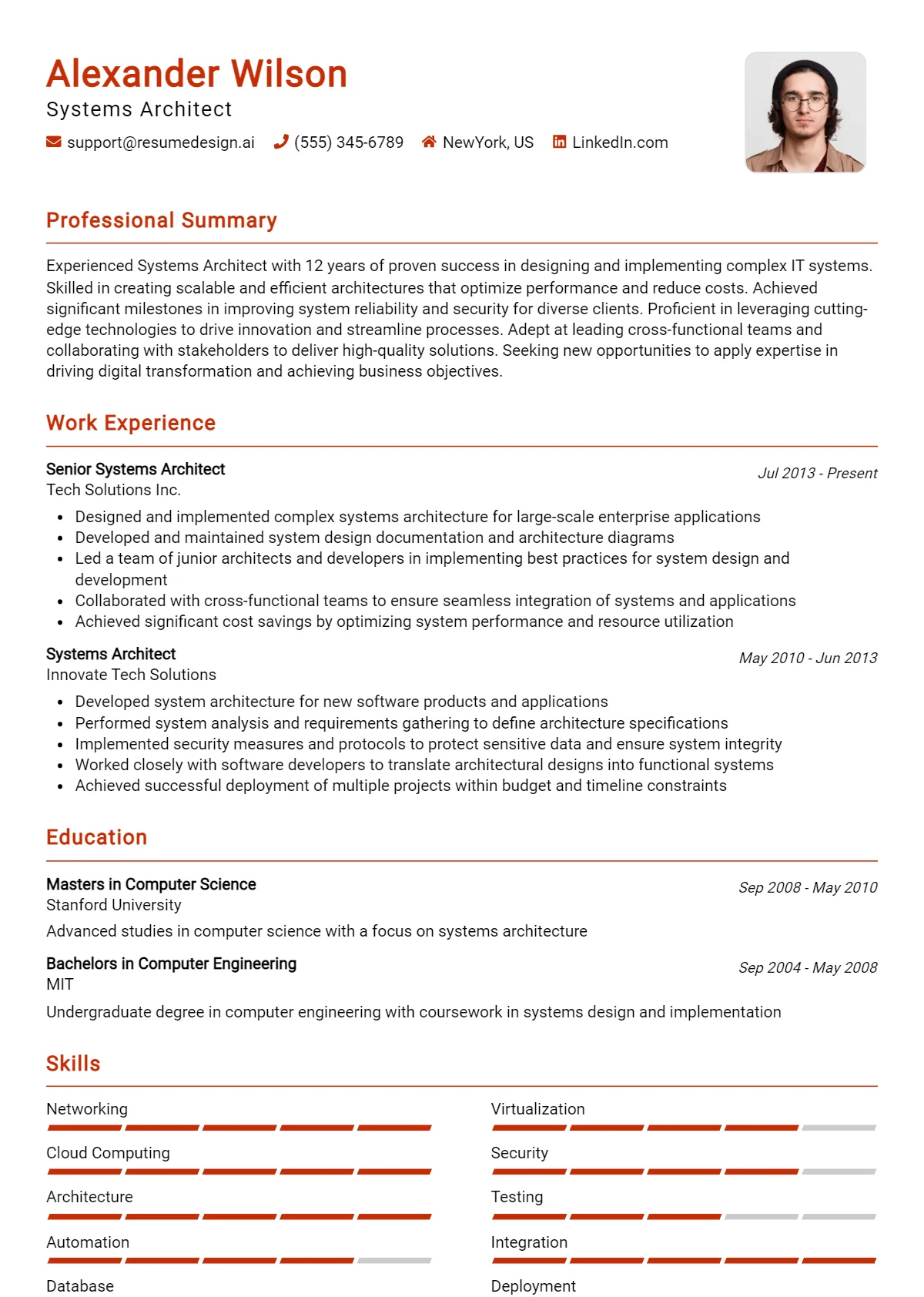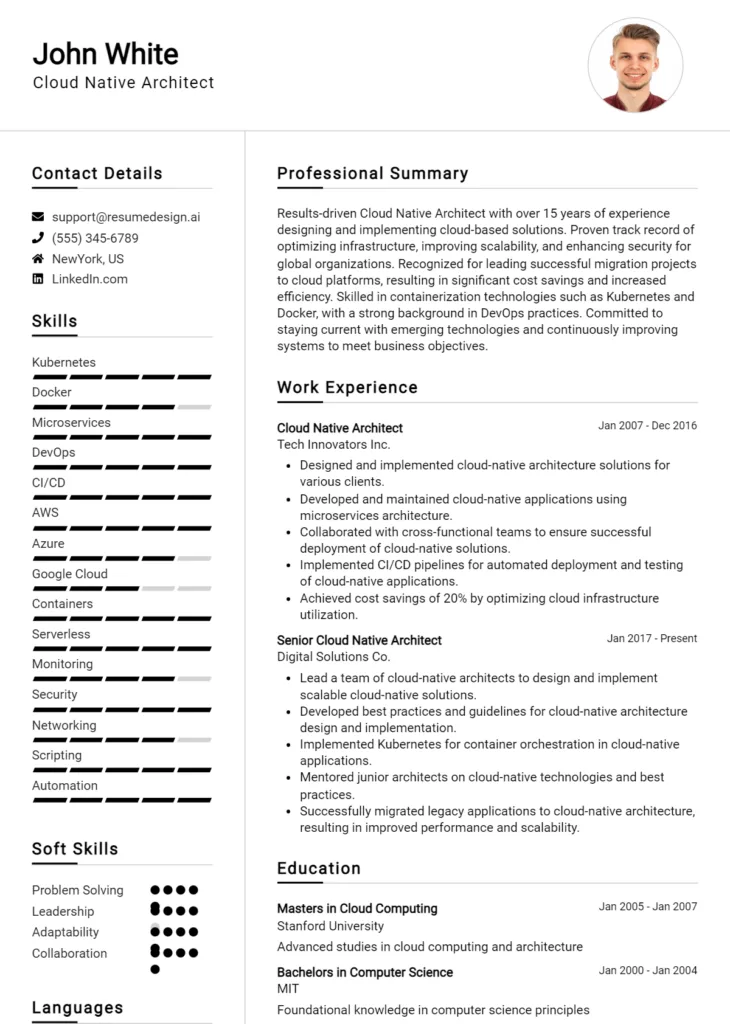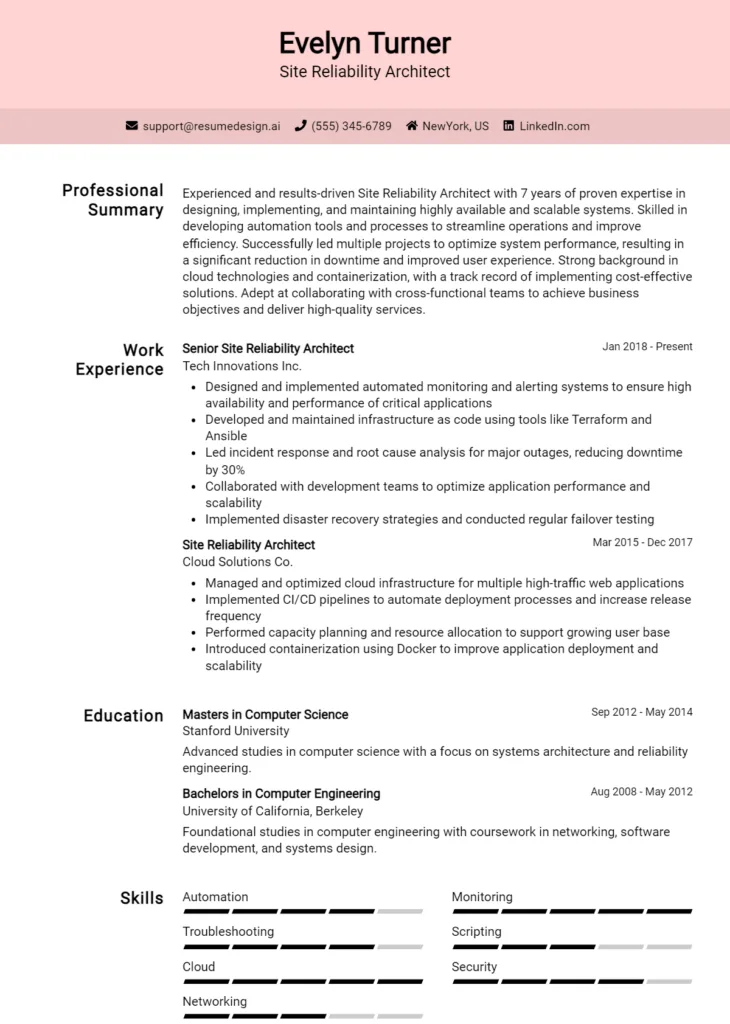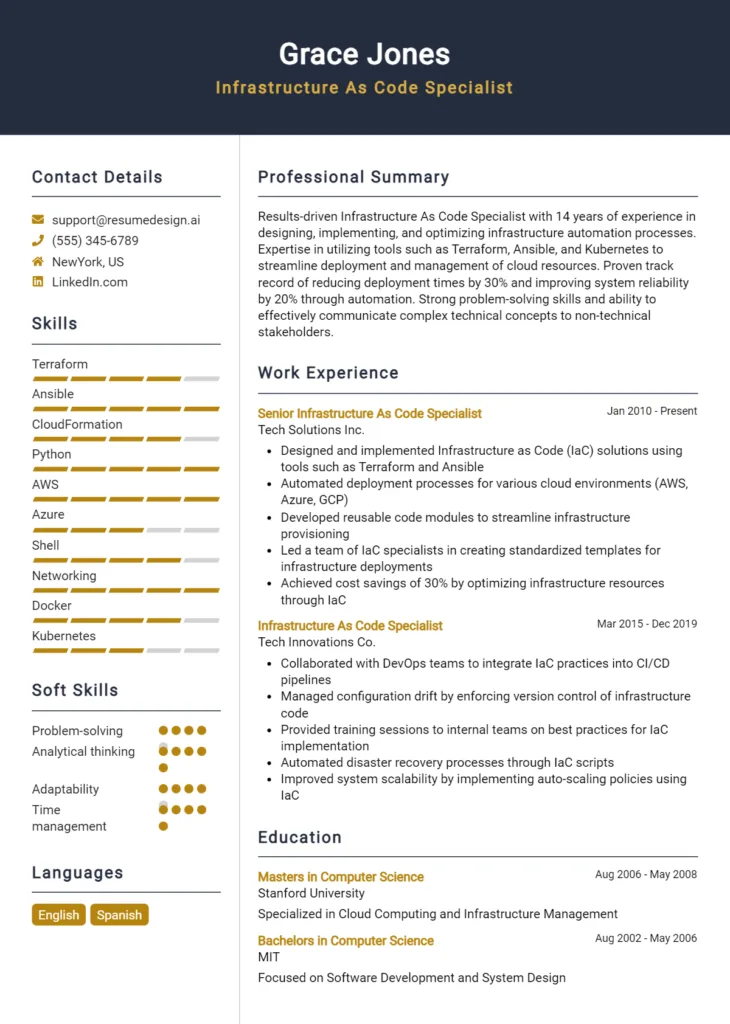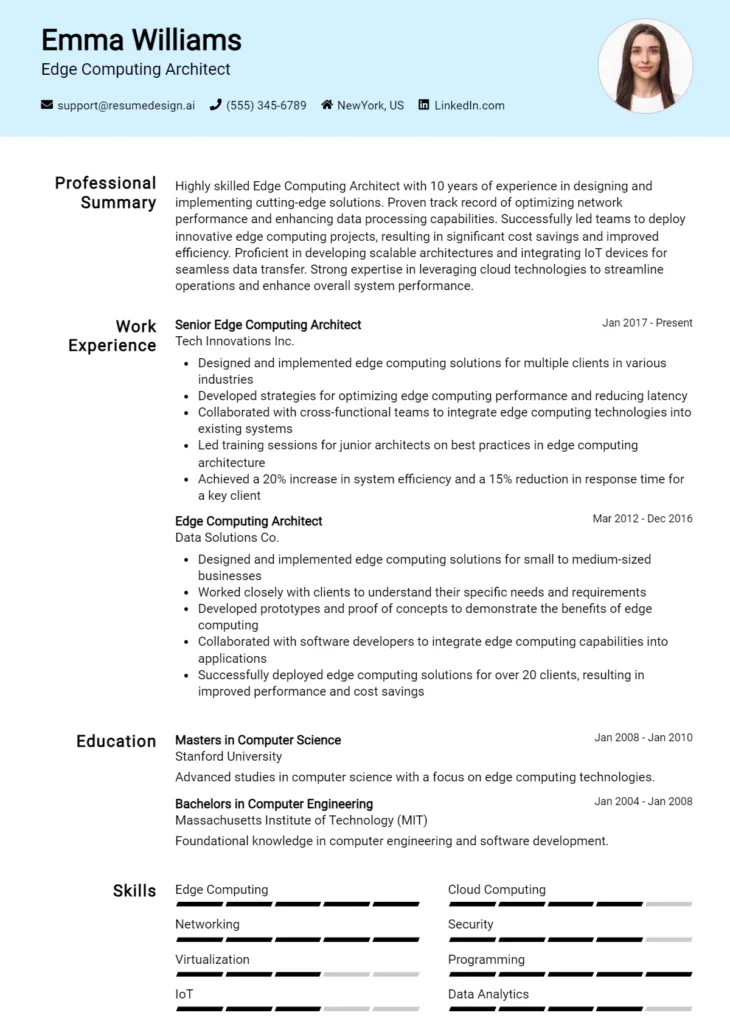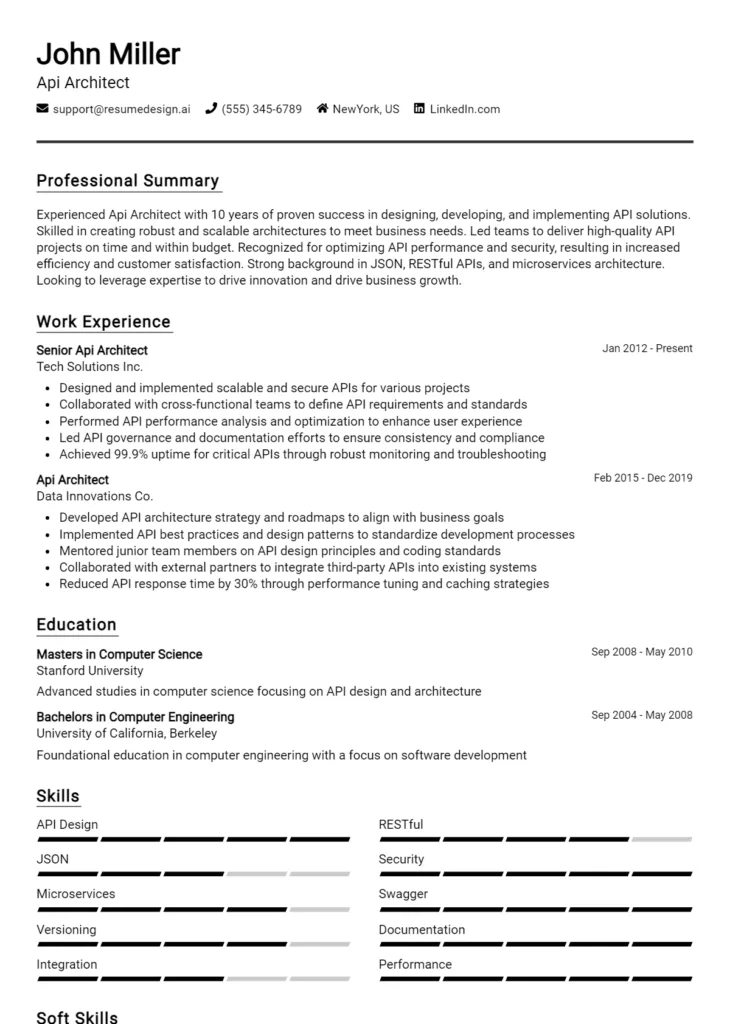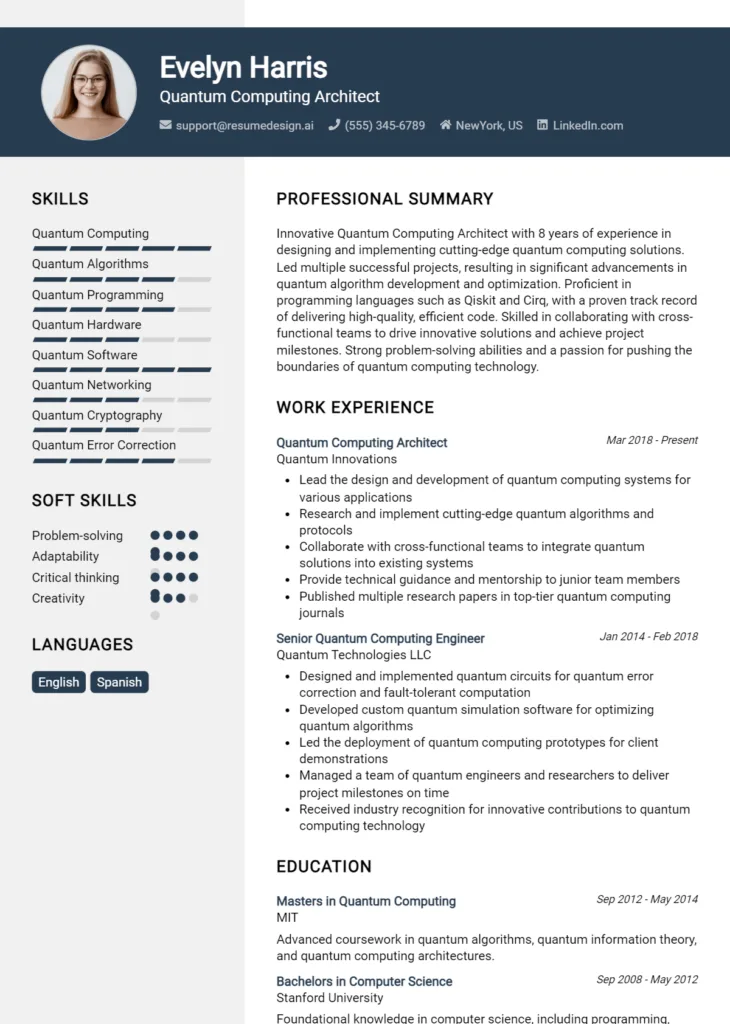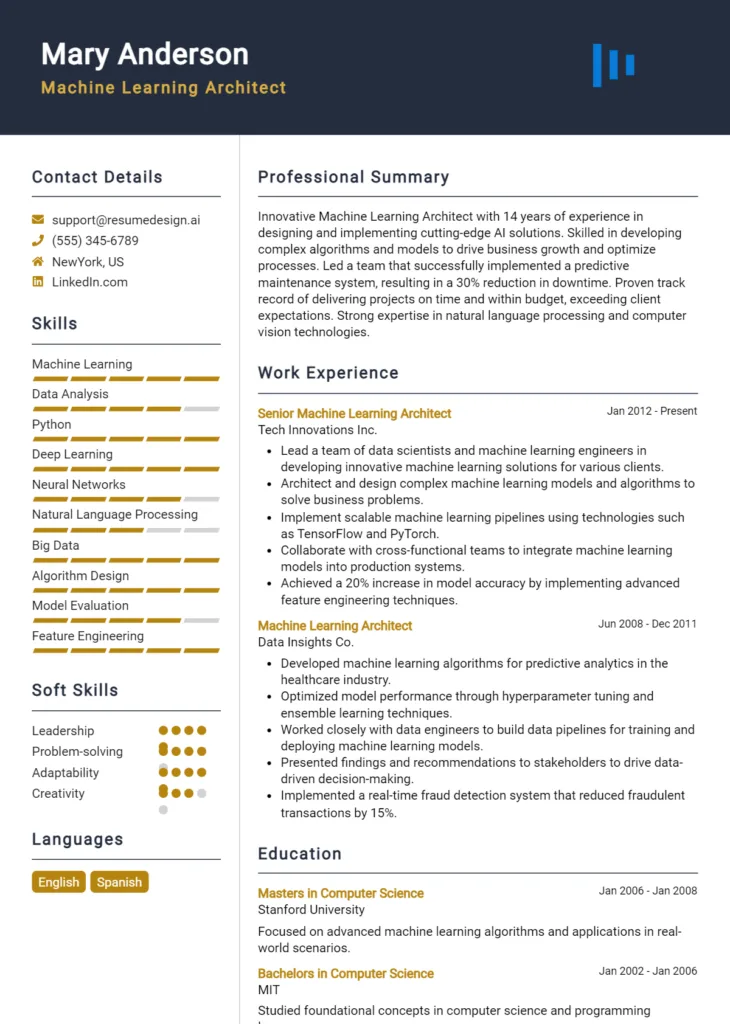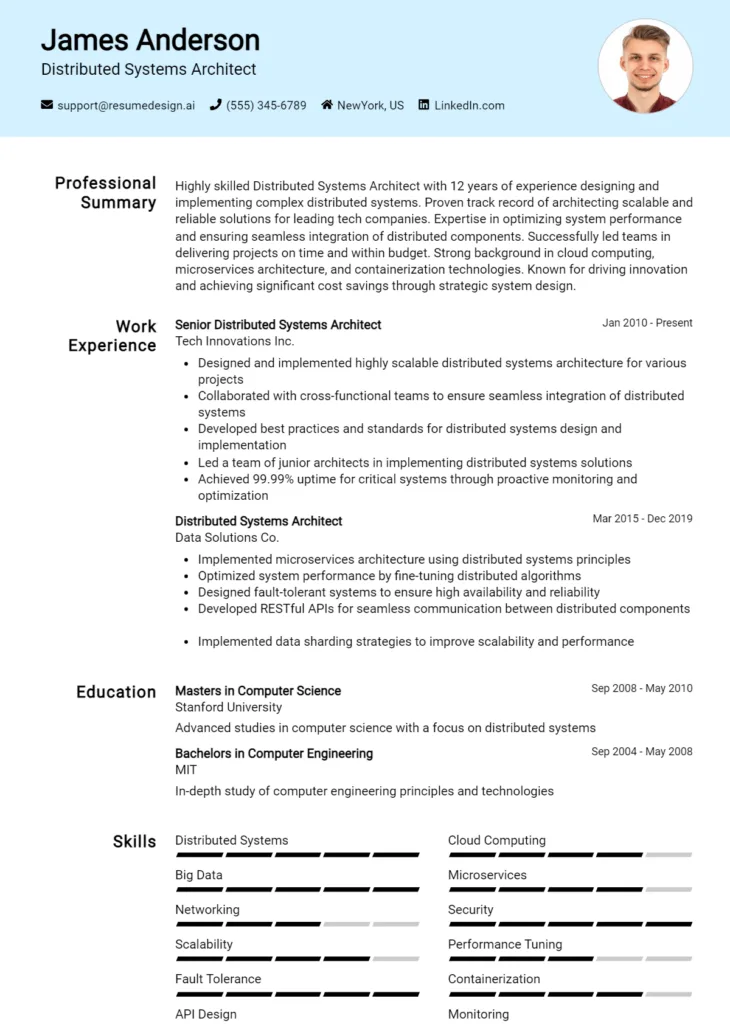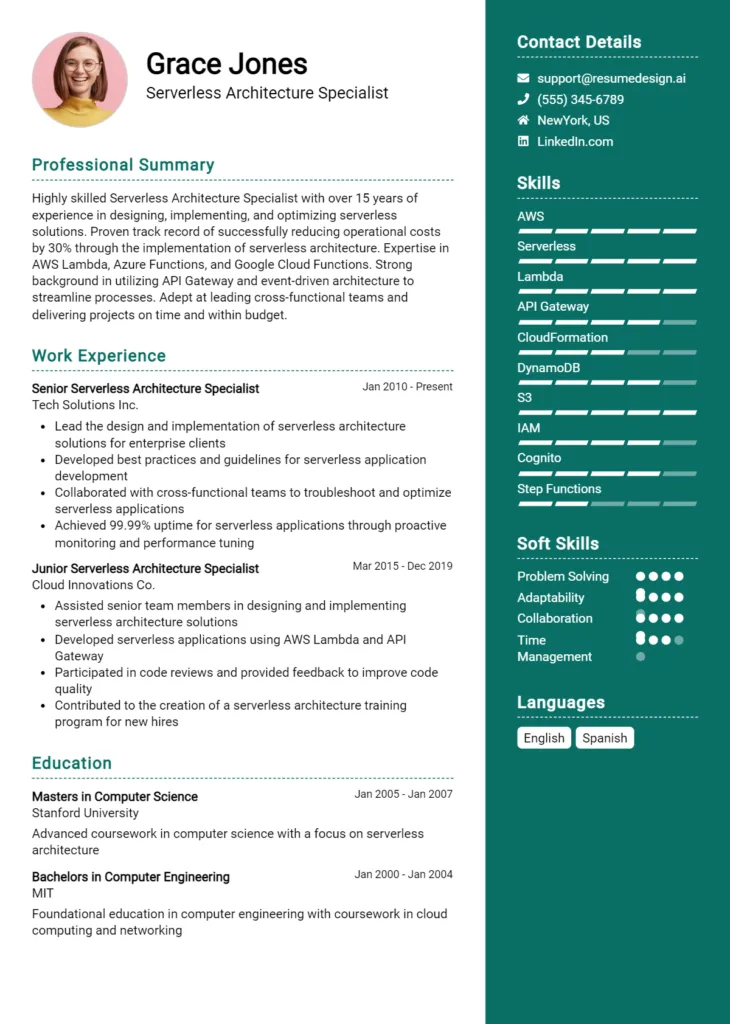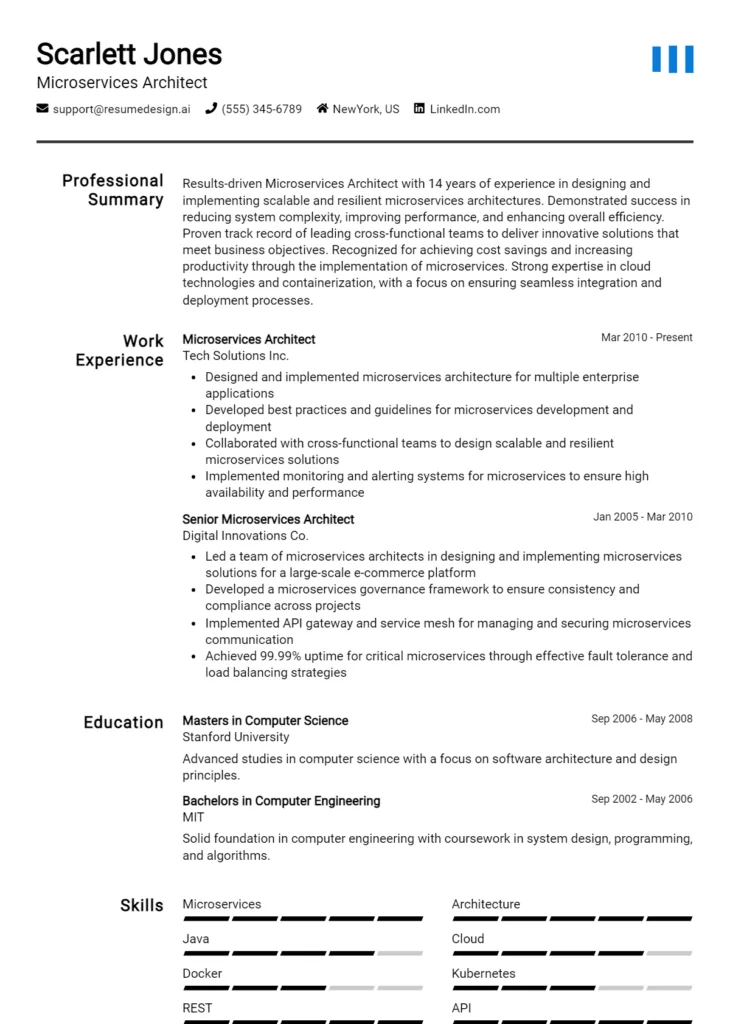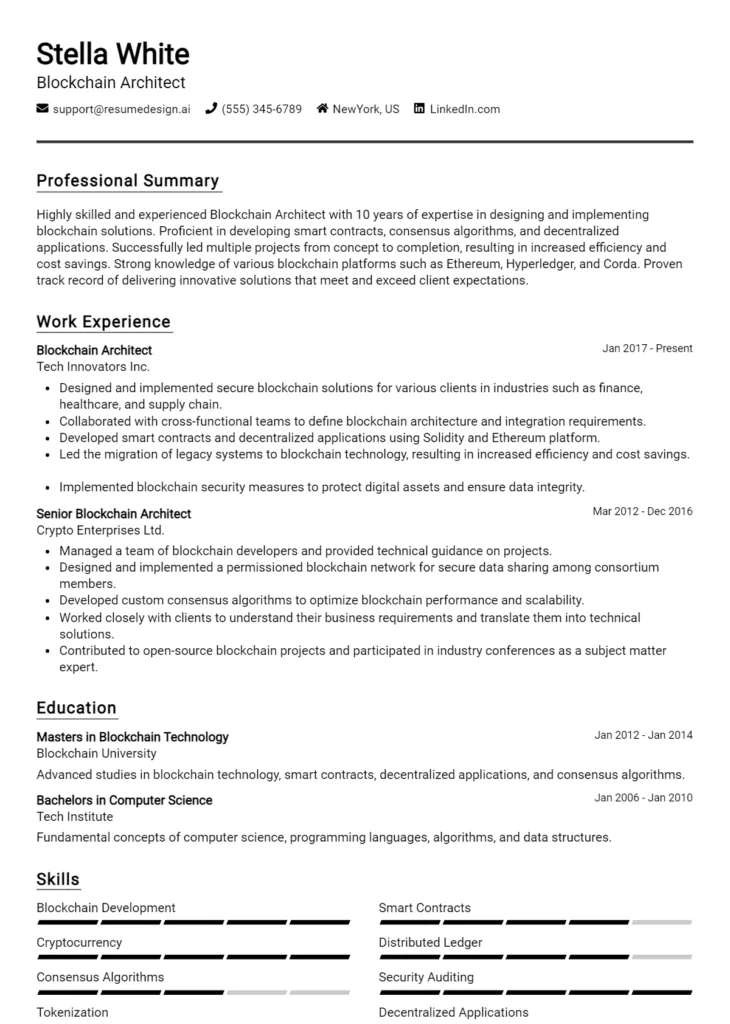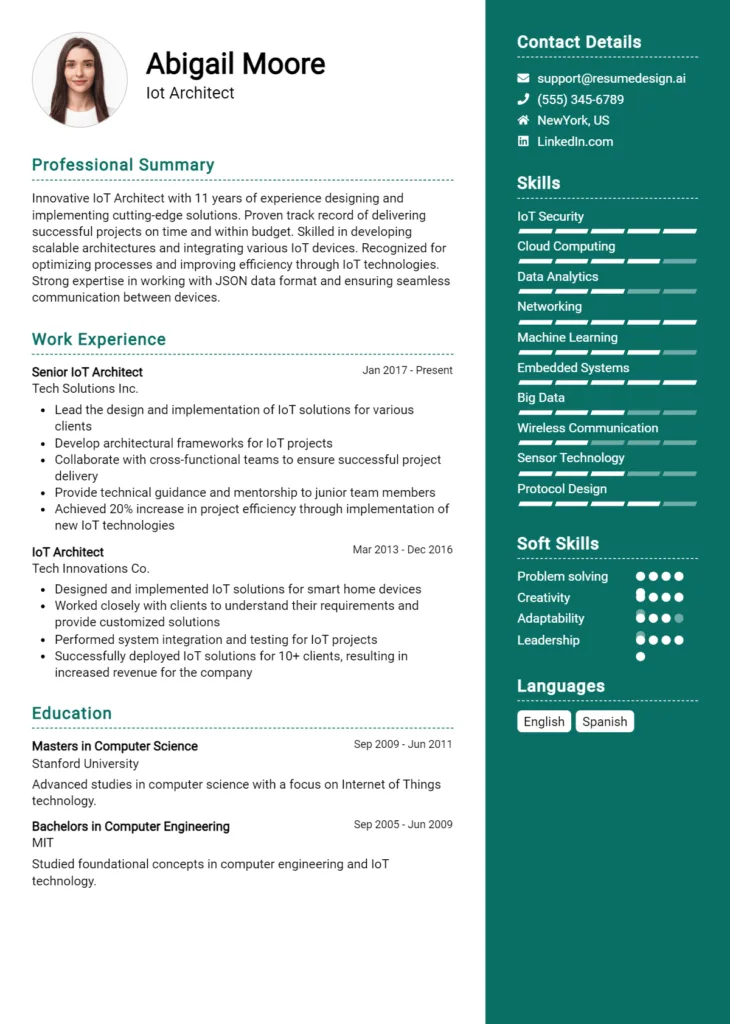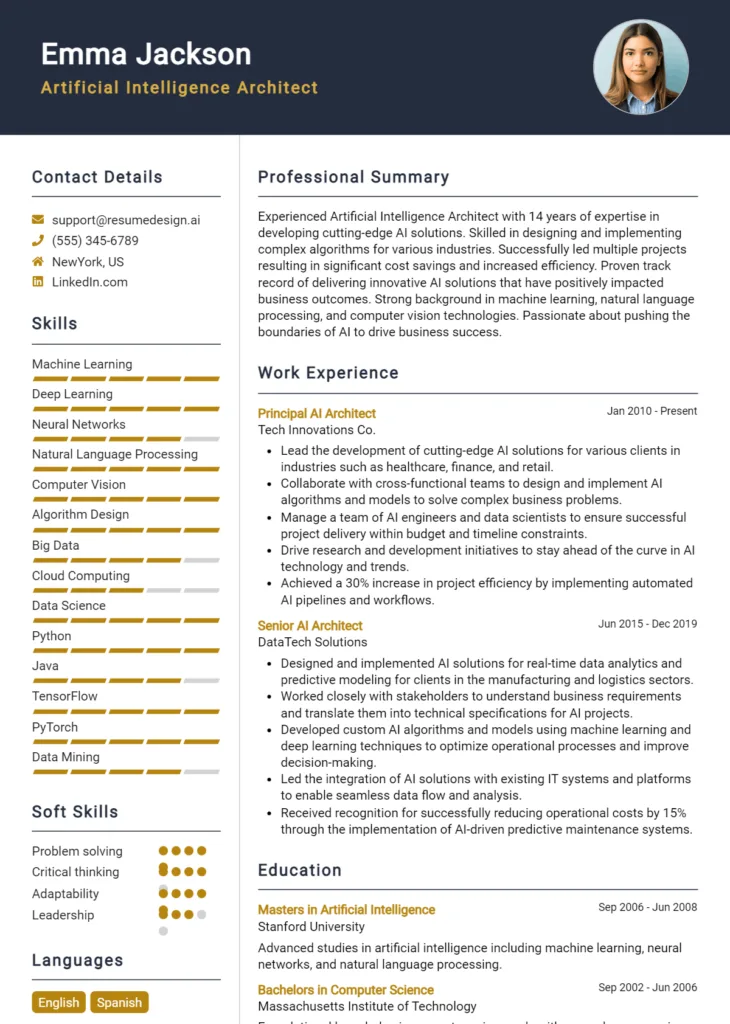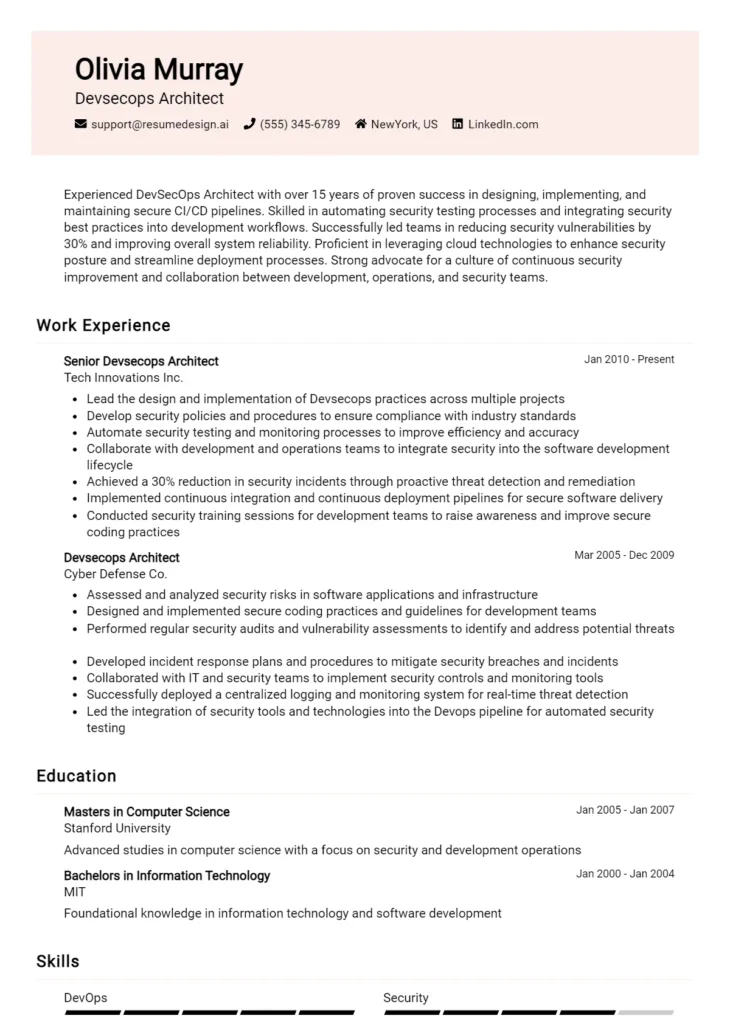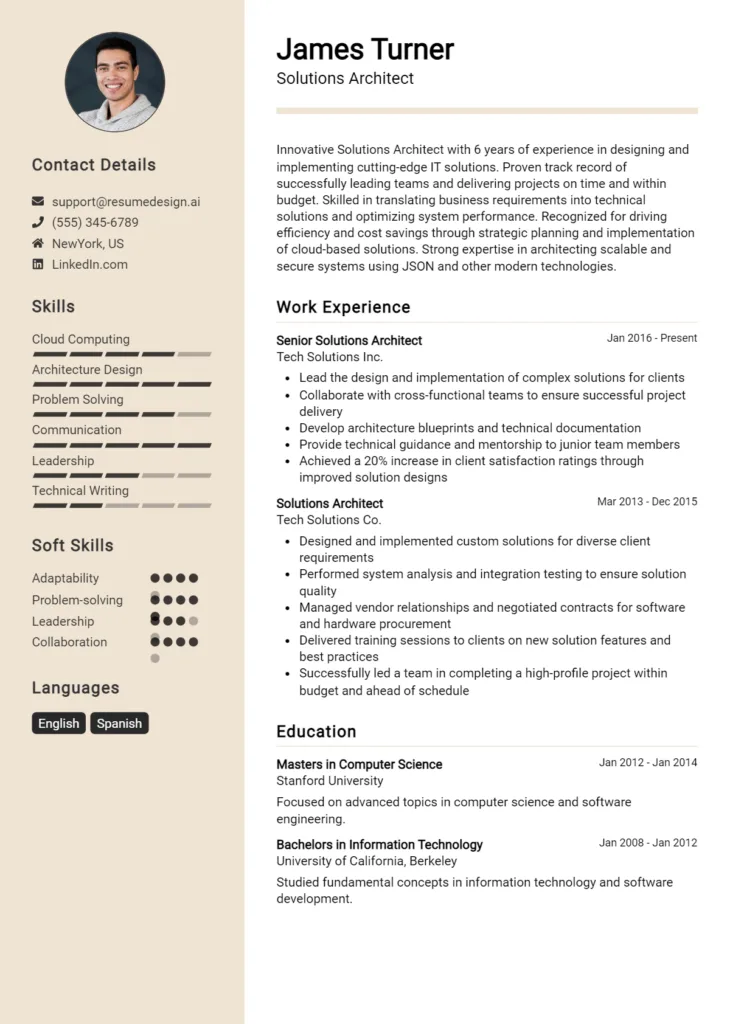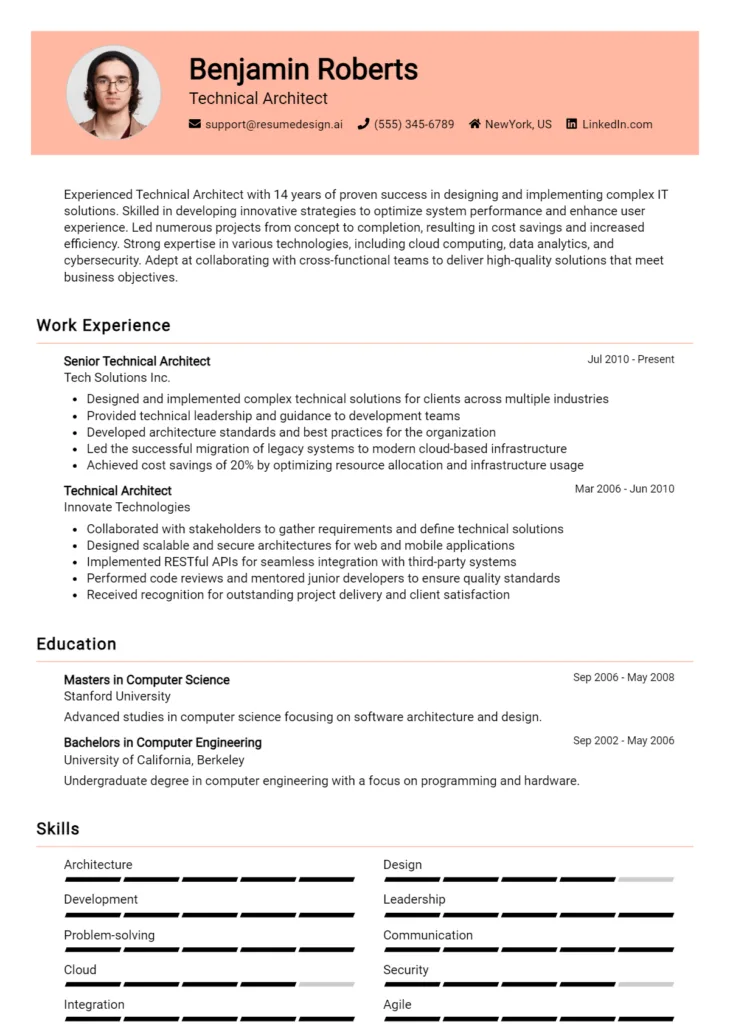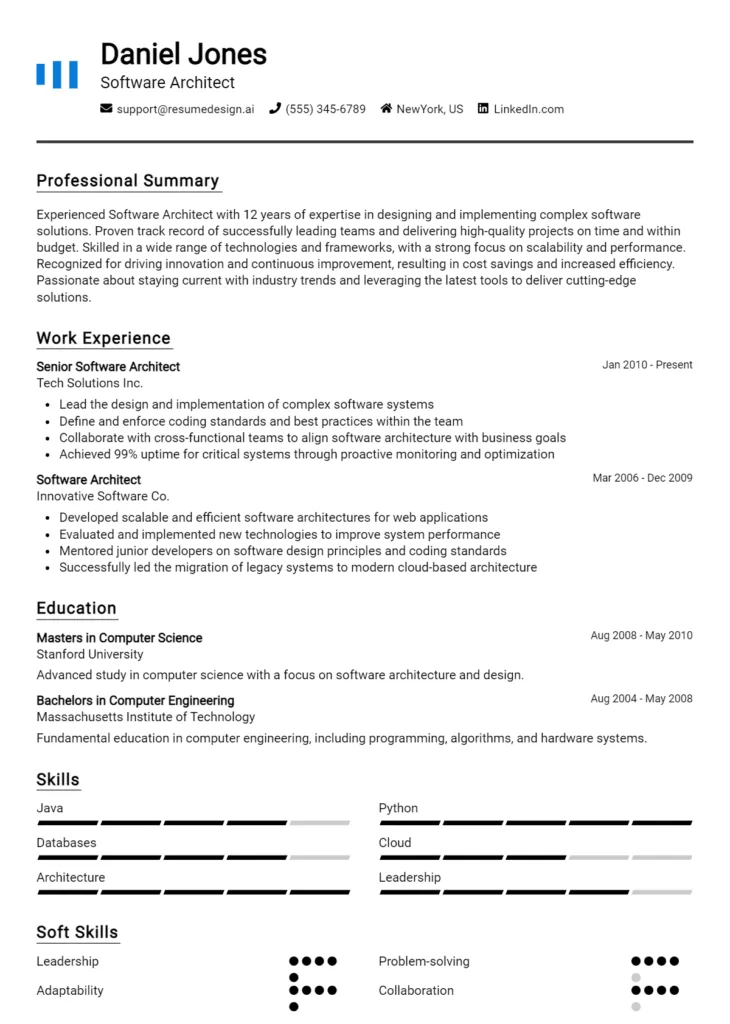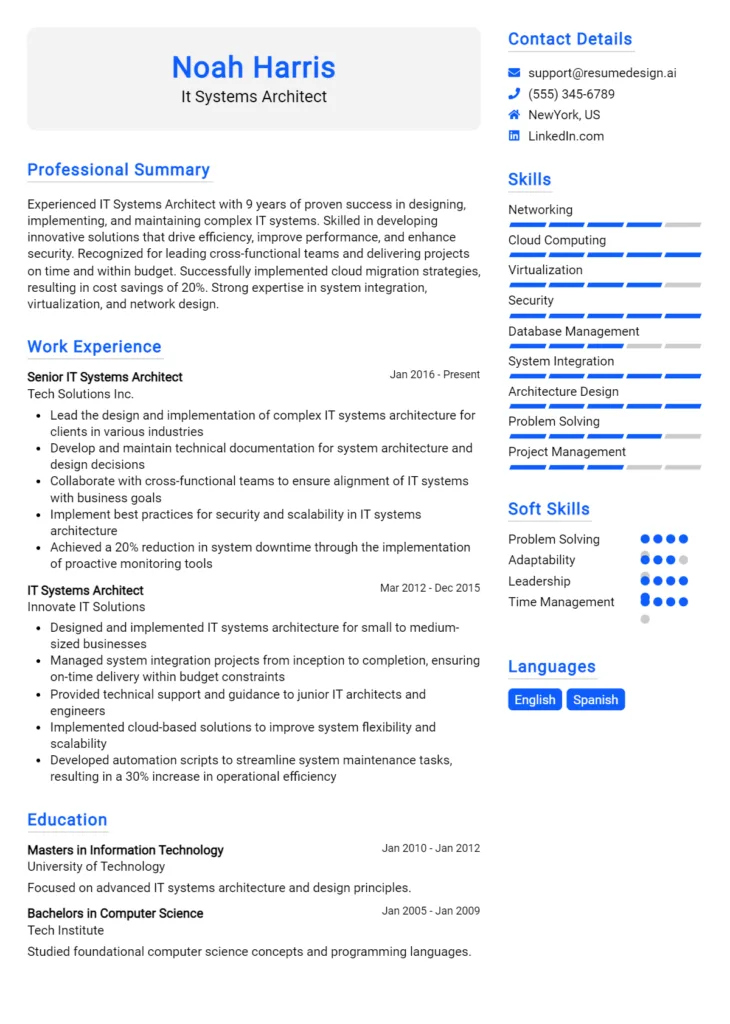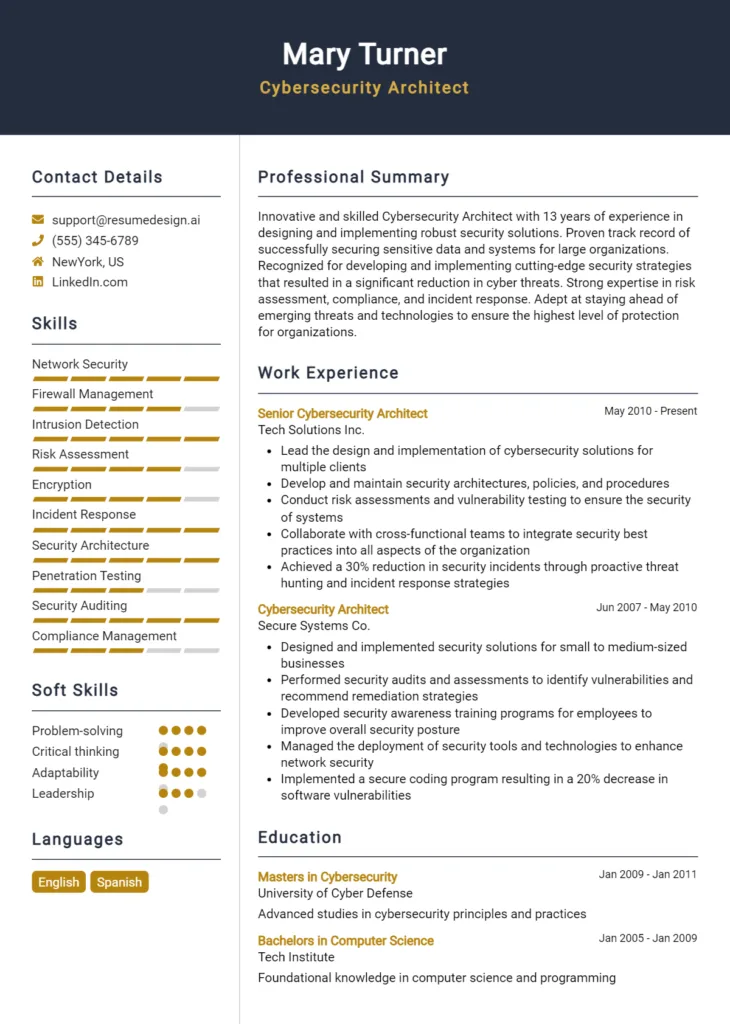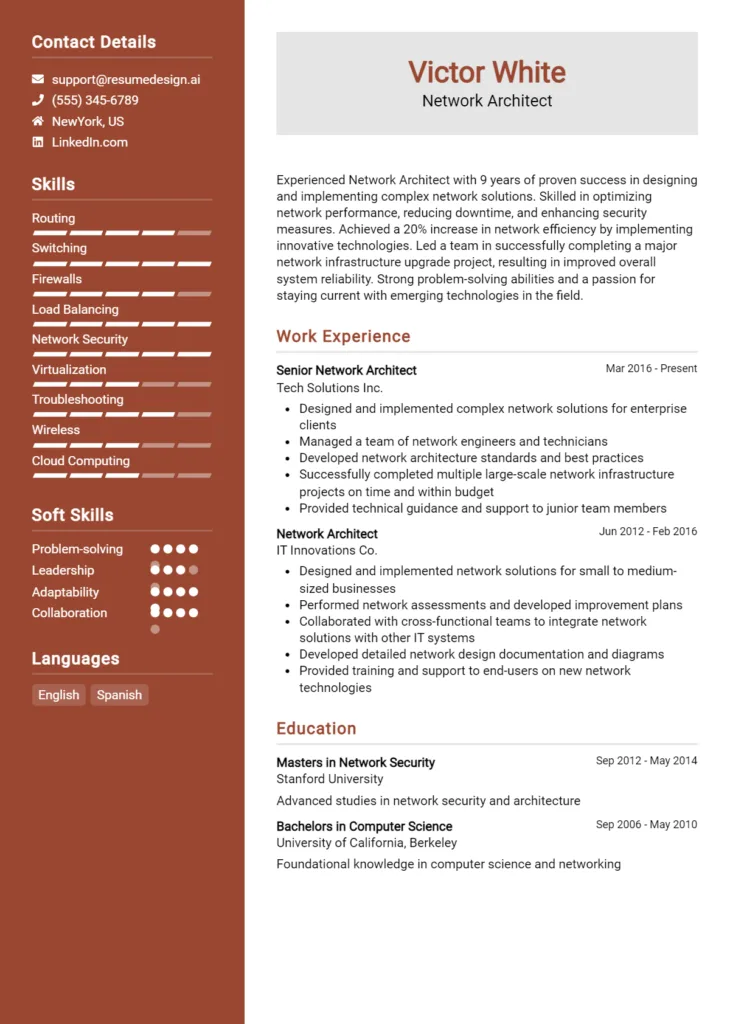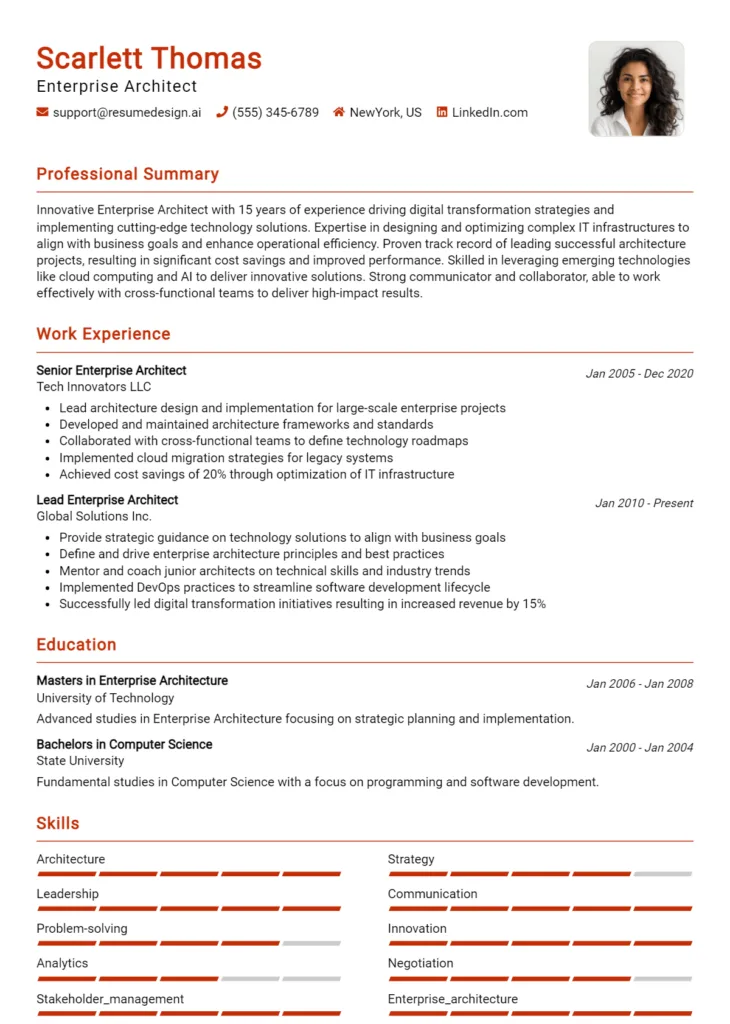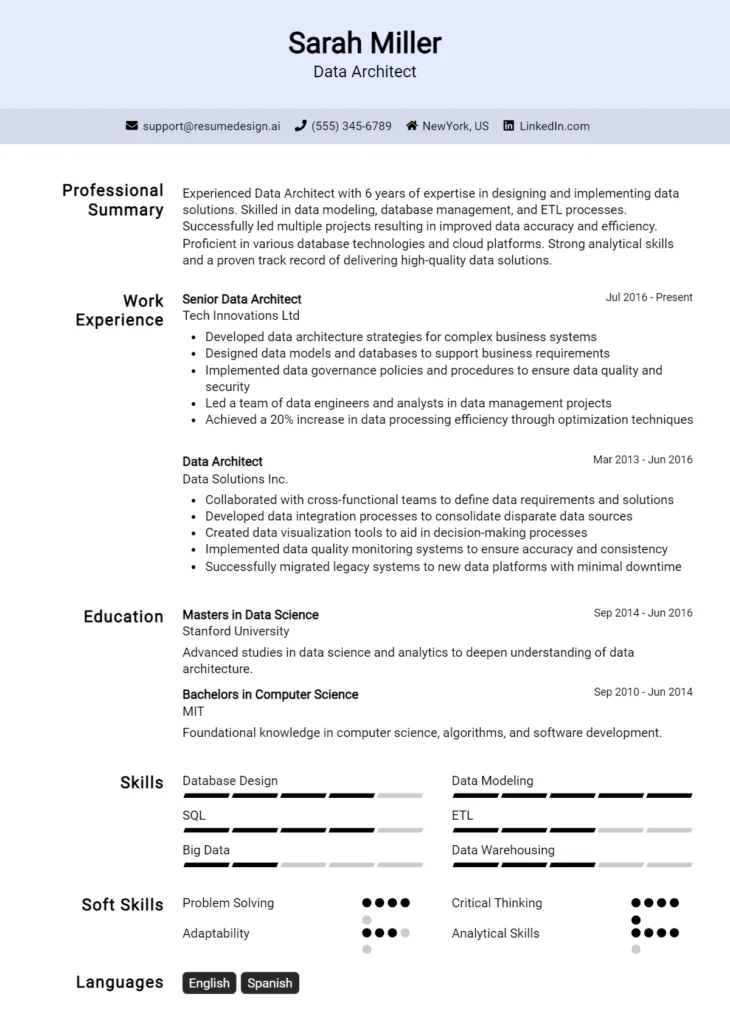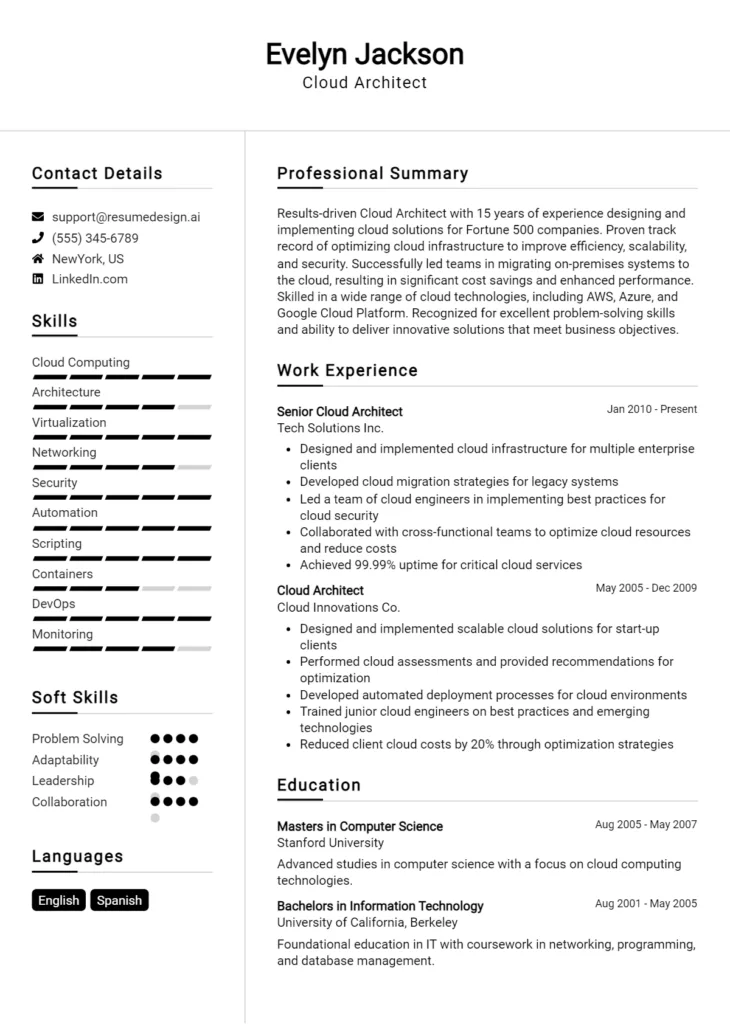Systems Architect Core Responsibilities
A Systems Architect plays a crucial role in designing and implementing complex systems that align with business objectives. This professional bridges various departments, ensuring seamless collaboration between technical teams and operational units. Key responsibilities include assessing system requirements, developing architectural frameworks, and troubleshooting issues. Essential skills encompass advanced technical knowledge, operational insight, and strong problem-solving abilities. These competencies are vital for achieving organizational goals, and a well-structured resume can effectively highlight these qualifications to prospective employers.
Common Responsibilities Listed on Systems Architect Resume
- Design and implement system architecture frameworks.
- Collaborate with cross-functional teams to define system requirements.
- Evaluate existing systems and recommend improvements.
- Ensure system scalability and performance optimization.
- Develop technical documentation and system specifications.
- Oversee the integration of new technologies into existing systems.
- Conduct risk assessments and implement security measures.
- Provide technical guidance and mentorship to development teams.
- Manage project timelines and deliverables effectively.
- Stay updated with industry trends and emerging technologies.
- Facilitate stakeholder communication and manage expectations.
- Analyze and troubleshoot system issues to ensure minimal downtime.
High-Level Resume Tips for Systems Architect Professionals
In today’s competitive job market, a well-crafted resume is essential for Systems Architect professionals aiming to make a lasting impression on potential employers. As the first point of contact between a candidate and a hiring manager, the resume must effectively showcase not only the technical skills and experiences of the applicant but also their achievements and contributions to previous roles. A strong resume serves as a powerful marketing tool that can open doors to new opportunities and elevate a candidate's profile in the eyes of recruiters. This guide will provide practical and actionable resume tips specifically tailored for Systems Architect professionals to help you stand out in your job search.
Top Resume Tips for Systems Architect Professionals
- Tailor your resume to each job description by incorporating relevant keywords and phrases from the posting to align your skills with the employer’s needs.
- Highlight your technical proficiency in systems architecture design, modeling, and implementation, ensuring that industry-specific tools and methodologies are evident.
- Showcase relevant experience by detailing your previous roles and responsibilities, focusing on projects that demonstrate your capabilities as a Systems Architect.
- Quantify your achievements wherever possible, using metrics to illustrate the impact of your work, such as performance improvements, cost savings, or successful project completions.
- Emphasize soft skills such as communication, leadership, and collaboration, which are crucial for working with cross-functional teams and stakeholders.
- Include certifications and continuous education relevant to systems architecture, such as TOGAF, AWS Certified Solutions Architect, or other specialized training.
- Utilize a clean and professional format that enhances readability, prioritizing key information and keeping the layout consistent.
- Incorporate a summary statement at the top of your resume that encapsulates your experience, skills, and career objectives, making it easy for employers to grasp your value at a glance.
- List technologies and frameworks you have worked with, ensuring to mention any emerging trends in the architecture space to showcase your up-to-date knowledge.
By implementing these tips, Systems Architect professionals can significantly enhance their resumes, making them more appealing to potential employers. A tailored, achievement-focused resume not only highlights your qualifications but also demonstrates your understanding of the role and the value you can bring to an organization, ultimately increasing your chances of landing a coveted position in the field.
Why Resume Headlines & Titles are Important for Systems Architect
In the competitive field of systems architecture, a well-crafted resume is essential for standing out among numerous applicants. Resume headlines and titles play a critical role in this process, as they serve as the first impression a hiring manager has of a candidate. A strong headline can immediately grab attention and succinctly summarize a candidate's key qualifications in one impactful phrase. It should be concise, relevant, and directly related to the job being applied for, effectively setting the tone for the rest of the resume.
Best Practices for Crafting Resume Headlines for Systems Architect
- Keep it concise: Aim for a headline that is no more than 10 words.
- Be role-specific: Tailor the headline to reflect the specific position you are applying for.
- Highlight key skills: Incorporate relevant technical skills or certifications that align with the job description.
- Showcase experience: Include years of experience or notable achievements in the field.
- Use action-oriented language: Start with action verbs to convey your proactive approach.
- Be unique: Avoid clichés and generic phrases that do not set you apart.
- Align with job requirements: Reflect the language and terminology used in the job posting.
- Focus on impact: Convey the value you bring to an organization through your headline.
Example Resume Headlines for Systems Architect
Strong Resume Headlines
Innovative Systems Architect with 10+ Years in Cloud Solutions
Results-Driven Architect Specializing in Scalable Enterprise Systems
Certified Systems Architect with Expertise in DevOps and Automation
Strategic Systems Architect Focused on Transforming IT Infrastructure
Weak Resume Headlines
Experienced Professional Seeking Job
Systems Architect with Various Skills
Hardworking Individual Looking for Opportunities
The strong headlines are effective because they clearly communicate the candidate’s specific strengths, relevant experience, and the value they bring to potential employers. Each headline uses targeted language that aligns with the demands of the systems architect role, making it easy for hiring managers to see the candidate's fit for the position. In contrast, the weak headlines fail to impress due to their vagueness and lack of focus; they do not highlight unique qualifications or demonstrate a clear connection to the job, leaving hiring managers uninspired and uncertain about the candidate's capabilities.
Writing an Exceptional Systems Architect Resume Summary
A well-crafted resume summary is essential for a Systems Architect as it serves as the first impression a hiring manager receives. In a highly technical and competitive field, a strong summary quickly captures attention by succinctly showcasing key skills, relevant experience, and notable accomplishments. This brief yet impactful introduction should be tailored to the specific job the candidate is applying for, ensuring that it resonates with the employer's needs and sets the tone for the rest of the resume.
Best Practices for Writing a Systems Architect Resume Summary
- Quantify Achievements: Use numbers and metrics to highlight your accomplishments and impact in previous roles.
- Focus on Key Skills: Emphasize the technical and soft skills that are most relevant to the Systems Architect position.
- Be Concise: Keep the summary brief, ideally within 3-5 sentences, to maintain the reader's interest.
- Tailor Your Summary: Customize your summary to align with the specific job description and company goals.
- Highlight Relevant Experience: Mention specific projects or roles that demonstrate your expertise in system architecture.
- Use Strong Action Verbs: Start sentences with powerful verbs to convey confidence and proactivity.
- Showcase Leadership: If applicable, highlight any leadership roles or responsibilities that showcase your ability to guide teams and projects.
- Include Industry Keywords: Incorporate terminology and keywords from the job description to pass through applicant tracking systems.
Example Systems Architect Resume Summaries
Strong Resume Summaries
Results-driven Systems Architect with over 10 years of experience in designing scalable enterprise solutions. Successfully led a team in implementing a cloud migration project that reduced operational costs by 30% while enhancing system performance and reliability.
Dynamic Systems Architect with expertise in microservices architecture and API integrations. Developed a high-availability system architecture that increased uptime by 25%, directly contributing to a 15% boost in customer satisfaction scores.
Innovative Systems Architect with a proven track record of delivering complex IT solutions across multiple industries. Spearheaded a project that streamlined data processing capabilities, improving processing time by 40% and resulting in significant cost savings.
Weak Resume Summaries
Experienced IT professional with a background in systems architecture and various technologies.
Systems Architect with skills in different programming languages and experience working on projects.
The examples provided illustrate clear distinctions between strong and weak resume summaries. Strong summaries effectively quantify achievements, specify skills relevant to the role, and demonstrate a direct impact on organizational success. In contrast, weak summaries lack detail, specificity, and measurable outcomes, making them less likely to capture the interest of hiring managers.
Work Experience Section for Systems Architect Resume
The work experience section of a Systems Architect resume is pivotal for demonstrating not only technical prowess but also the candidate's capability to lead teams and deliver high-quality products. This section serves as a platform to showcase relevant skills and accomplishments that align with industry standards. Highlighting quantifiable achievements—such as successful project completions, cost savings, or improved system efficiencies—can significantly enhance a candidate's appeal to potential employers. By articulating experience in a clear and compelling manner, candidates can effectively convey their value to organizations seeking to innovate and optimize their IT systems.
Best Practices for Systems Architect Work Experience
- Clearly outline technical skills relevant to the position, such as cloud architecture, microservices, and system integration.
- Quantify achievements with metrics, like percentage improvements in performance or cost reductions.
- Emphasize leadership roles and team management experiences to showcase your ability to guide projects and collaborate effectively.
- Use industry-standard terminology and frameworks to demonstrate familiarity with best practices.
- Tailor each experience to align with the job description, highlighting relevant technologies and methodologies.
- Include project outcomes and lessons learned to reflect on your problem-solving capabilities.
- Highlight cross-functional collaboration with other departments or stakeholders to illustrate teamwork and communication skills.
- Keep descriptions concise and focused on achievements rather than duties to maintain reader engagement.
Example Work Experiences for Systems Architect
Strong Experiences
- Led a cross-functional team to design and implement a cloud-based architecture that reduced operational costs by 25% and improved system scalability.
- Developed a microservices architecture for a major product line that increased deployment speed by 40%, enabling faster go-to-market times.
- Collaborated with IT and business units to streamline system integration processes, resulting in a 30% reduction in project delivery times.
- Successfully migrated legacy systems to a new platform, enhancing system performance by 50% and minimizing downtime during the transition.
Weak Experiences
- Worked on various IT projects without specifying roles or contributions.
- Helped with system upgrades and maintenance tasks.
- Participated in team meetings and discussions about system performance.
- Involved in some cloud initiatives with no clear outcomes or metrics provided.
The strong experiences listed above are distinguished by their focus on quantifiable outcomes and specific contributions to projects, highlighting the candidate's technical expertise and leadership abilities. In contrast, the weak experiences lack detail, specificity, and measurable results, making it difficult for potential employers to assess the candidate's impact or relevance to the Systems Architect role. Strong experiences paint a picture of a proactive, results-oriented professional, while weak experiences convey a lack of engagement or clarity in past roles.
Education and Certifications Section for Systems Architect Resume
The education and certifications section of a Systems Architect resume is crucial as it serves to validate the candidate's academic qualifications and industry expertise. This section provides potential employers with a clear view of the candidate's foundational knowledge, specialized skills, and ongoing commitment to professional development. By including relevant coursework, industry-recognized certifications, and any specialized training, candidates can significantly enhance their credibility and demonstrate a strong alignment with the requirements of the Systems Architect role.
Best Practices for Systems Architect Education and Certifications
- Prioritize relevant degrees such as Computer Science, Information Technology, or Systems Engineering.
- Highlight industry-recognized certifications, such as TOGAF, AWS Certified Solutions Architect, or Microsoft Azure Architect.
- Include specialized training programs that align with current technologies and practices in systems architecture.
- Provide details on relevant coursework that showcases specific skills or knowledge pertinent to systems architecture.
- Emphasize advanced degrees (e.g., Master's or Ph.D.) that can set candidates apart in competitive job markets.
- Keep the information concise and focused, avoiding unnecessary details that don’t directly relate to the role.
- Update the section regularly to reflect new certifications or relevant educational accomplishments.
- Consider including ongoing education or webinars to demonstrate a commitment to lifelong learning.
Example Education and Certifications for Systems Architect
Strong Examples
- M.S. in Computer Science, Stanford University, 2020
- AWS Certified Solutions Architect – Professional, 2022
- TOGAF 9 Certified Architect, 2021
- Relevant Coursework: Cloud Computing, Software Architecture, and Systems Integration
Weak Examples
- B.A. in History, University of California, 2015
- Certification in Basic Computer Skills, 2010
- Completed an online course on Social Media Marketing, 2021
- High School Diploma, 2012
The strong examples are considered effective because they directly align with the Systems Architect role, showcasing advanced degrees, relevant certifications, and coursework that highlight the candidate's expertise in the field. In contrast, the weak examples fail to demonstrate relevance to the position, featuring outdated or unrelated qualifications that do not contribute to the candidate's suitability for a systems architecture role.
Top Skills & Keywords for Systems Architect Resume
In the competitive field of systems architecture, a well-crafted resume is essential for standing out to potential employers. Highlighting the right skills is crucial, as it demonstrates not only your technical prowess but also your ability to collaborate and communicate effectively within a team. A Systems Architect must possess a blend of hard and soft skills to successfully design, implement, and manage complex systems. These skills reflect your proficiency in various domains and your capacity to adapt to evolving technologies and methodologies. An impressive resume that showcases these skills can significantly enhance your chances of landing an interview and ultimately securing a position.
Top Hard & Soft Skills for Systems Architect
Soft Skills
- Effective Communication
- Problem-Solving
- Team Collaboration
- Critical Thinking
- Adaptability
- Leadership
- Conflict Resolution
- Time Management
- Creativity
- Attention to Detail
- Stakeholder Management
- Strategic Planning
- Emotional Intelligence
- Negotiation Skills
Hard Skills
- Systems Design
- Cloud Computing (AWS, Azure, Google Cloud)
- Network Architecture
- Database Management (SQL, NoSQL)
- Security Protocols
- DevOps Practices
- Programming Languages (Java, Python, C#)
- Enterprise Architecture Frameworks (TOGAF, Zachman)
- Integration Techniques (API, Microservices)
- Agile Methodologies (Scrum, Kanban)
- Infrastructure as Code (Terraform, Ansible)
- Virtualization (VMware, Hyper-V)
- Software Development Life Cycle (SDLC)
- Performance Tuning and Optimization
- Data Modeling and Analysis
By ensuring that your resume reflects both your hard and soft skills, you can effectively convey your qualifications and readiness for the challenges faced by a Systems Architect. Don’t forget to complement these skills with a strong work experience section that illustrates your practical application of these abilities.
Stand Out with a Winning Systems Architect Cover Letter
Dear [Hiring Manager's Name],
I am writing to express my interest in the Systems Architect position at [Company Name], as advertised on [Job Board/Company Website]. With over [X years] of experience in designing and implementing complex systems architecture, I have developed a robust skill set that aligns perfectly with the requirements of this role. My background in both software engineering and infrastructure design has equipped me with the unique ability to bridge the gap between technical and business needs, ensuring that the systems I architect not only meet current demands but are also scalable for future growth.
Throughout my career, I have successfully led numerous projects that required a deep understanding of both high-level architecture and the intricate details of system integration. At [Previous Company Name], I spearheaded the design of a cloud-based solution that streamlined operations, resulting in a [specific percentage] increase in efficiency and a significant reduction in operational costs. My proficiency in various architecture frameworks and methodologies, including TOGAF and Agile, allows me to adapt to changing project requirements while ensuring the delivery of high-quality solutions. I am passionate about leveraging emerging technologies to drive innovation and enhance system performance, and I am excited about the opportunity to bring this expertise to [Company Name].
Collaboration is at the heart of successful system architecture, and I pride myself on my ability to work effectively with cross-functional teams. My experience in mentoring junior developers and conducting architecture reviews has not only honed my leadership skills but also fostered a culture of continuous improvement and knowledge sharing. I am particularly drawn to [Company Name] because of its commitment to [specific value or project], and I am eager to contribute to your mission by developing systems that empower your teams and delight your customers.
Thank you for considering my application. I am looking forward to the opportunity to discuss how my skills and experience align with the needs of your team. I am excited about the possibility of contributing to the innovative projects at [Company Name] and am eager to bring my expertise in systems architecture to your organization.
Sincerely,
[Your Name]
[Your LinkedIn Profile]
[Your Contact Information]
Common Mistakes to Avoid in a Systems Architect Resume
A well-crafted resume is crucial for a Systems Architect seeking to showcase their technical expertise and architectural vision. However, many candidates make common mistakes that can undermine their chances of landing an interview. By avoiding these pitfalls, you can create a compelling resume that effectively highlights your skills and experiences. Here are some common mistakes to steer clear of:
Lack of Tailoring: Failing to customize your resume for the specific job description can make it seem generic. Use keywords from the job listing to demonstrate that you meet the employer's needs.
Overloading with Technical Jargon: While technical skills are important, using excessive jargon can alienate hiring managers who may not be familiar with every term. Aim for clarity and balance technical language with accessible explanations.
Ignoring Soft Skills: Systems architects not only need technical skills but also soft skills such as communication and leadership. Neglecting to mention these can give an incomplete picture of your capabilities.
Vague Job Descriptions: Providing unclear or overly broad descriptions of previous roles can lead to confusion. Use specific examples and quantify achievements to illustrate your impact in past positions.
Skipping Key Certifications: Failing to include relevant certifications can be a missed opportunity to highlight your qualifications. Make sure to list any relevant credentials that align with the job requirements.
Neglecting Project Highlights: Systems architects often work on complex projects. Omitting key projects from your resume can diminish your credibility. Include standout projects with descriptions of your role and the outcomes achieved.
Inconsistent Formatting: A resume that lacks a consistent format can be difficult to read and appear unprofessional. Ensure that fonts, bullet points, and spacing are uniform throughout the document for a polished look.
Forgetting to Showcase Results: Simply listing responsibilities without demonstrating the results of your work can weaken your resume. Focus on accomplishments that showcase your contributions to system architecture and design.
Conclusion
As we explored the essential responsibilities and skills required for a Systems Architect, it’s clear that this role demands a blend of technical expertise, strategic thinking, and effective communication. A Systems Architect plays a crucial role in designing and implementing complex systems, ensuring they align with organizational goals while also being scalable and efficient. Key competencies include proficiency in various programming languages, understanding of system architecture frameworks, and the ability to collaborate with cross-functional teams.
Moreover, staying updated with the latest technological advancements and industry best practices is vital for success in this position. With the increasing demand for digital transformation across industries, the need for skilled Systems Architects is on the rise, making it an opportune time to refine your professional profile.
Now is the perfect moment to evaluate and enhance your Systems Architect resume. Ensure it reflects your expertise, experiences, and the unique value you bring to a potential employer. To assist you in this process, consider utilizing the following resources:
- Resume Templates to find designs that suit your professional style.
- Resume Builder for an easy and efficient way to create a polished resume.
- Resume Examples for inspiration from successful Systems Architects.
- Cover Letter Templates to accompany your resume and make a strong first impression.
Take action today to ensure your resume stands out in this competitive job market!

